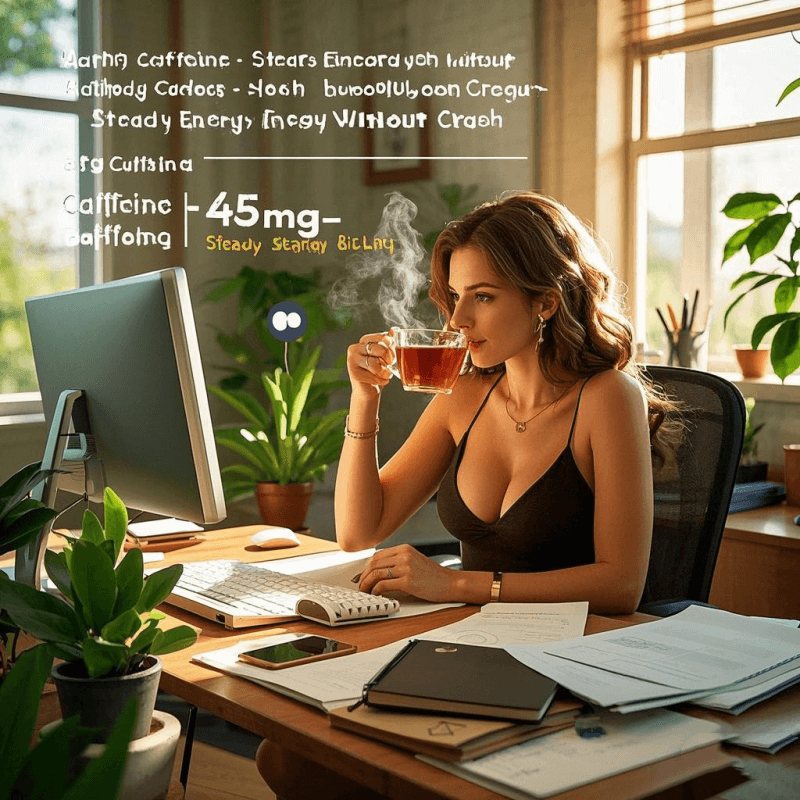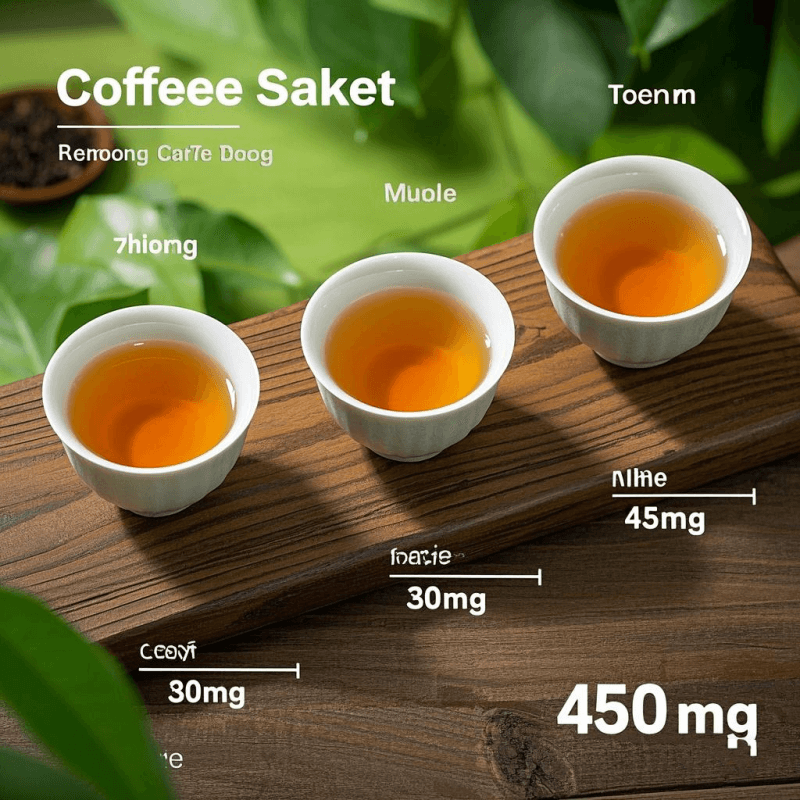How Much Caffeine Does Oolong Tea Have?

1. Introduction: Why “How Much Caffeine Does Oolong Tea Have” Matters
As more people embrace oolong tea for its intricate flavors and potential health benefits, the query “how much caffeine does oolong tea have” has gained traction. Caffeine intake plays a pivotal role in daily routines, influencing energy levels, sleep patterns, and overall well-being. A 2023 survey by Tea Health Insights revealed that 65% of oolong tea enthusiasts actively seek information about its caffeine content to make informed consumption choices. This article demystifies the caffeine profile of oolong tea, explores its physiological effects, and offers tailored advice to help you integrate this semi-oxidized brew into your lifestyle harmoniously.
2. What Is Oolong Tea? A Quick Overview
Oolong tea occupies a unique space in the tea world, stemming from Camellia sinensis leaves that undergo partial oxidation (10–80%). This processing method places it on a spectrum between the fresh, grassy notes of green tea (minimally oxidized) and the bold, malty flavors of black tea (fully oxidized). Originating in China’s Fujian province during the Ming Dynasty, oolong tea has since spread to Taiwan, Sri Lanka, and India, evolving into hundreds of varietals with distinct flavor profiles.
The Art of Oolong Processing
The magic of oolong tea lies in its meticulous production:
- Withering: Freshly plucked leaves are laid out to wilt, either under the sun or in shaded, ventilated rooms. This step reduces moisture content (from 75% to 60–65%) and activates enzymes like polyphenol oxidase, setting the stage for oxidation.
- Oxidation (Qichang): Leaves are gently tossed in bamboo baskets to bruise their edges, exposing cell sap to air. Artisans monitor this process closely; light oxidation (10–30%) yields floral, fruity notes (e.g., Taiwanese Alishan), while heavy oxidation (60–80%) creates smoky, roasted flavors (e.g., Wuyi Da Hong Pao).
- Firing: Oxidation is halted by pan-firing or baking the leaves, a step that stabilizes flavors and prevents further chemical reactions. Roasted oolongs may undergo additional charcoal firing to develop depth.
This balance of oxidation and heat treatment not only shapes oolong tea’s taste but also impacts its caffeine structure. Unlike green tea, where caffeine remains largely unbound, oolong tea’s moderate oxidation allows some caffeine molecules to complex with polyphenols, potentially slowing their absorption and creating a smoother stimulant effect.
3. How Much Caffeine Does Oolong Tea Have? The Numbers Breakdown
How Much Caffeine Does Oolong Tea Have:
Caffeine content in oolong tea is not one-size-fits-all; it fluctuates based on three primary factors:
1. Oxidation Level: The Primary Driver
- Lightly Oxidized (10–30%): Teas like Tie Guan Yin (Iron Goddess of Mercy) or Alishan High Mountain retain more of the leaf’s original caffeine due to minimal enzymatic activity. Expect 30–40mg per 8oz cup, with a gentle, sustained energy lift.
- Moderately Oxidized (30–60%): Varieties such as Wuyi Shui Xian or Taiwan Jin Xuan (Milk Oolong) strike a balance, offering 40–50mg of caffeine. Their oxidation process breaks down some caffeine-polyphenol complexes, releasing a moderate dose ideal for daily consumption.
- Heavily Oxidized (60–80%): Robust teas like Da Hong Pao or Phoenix Dan Cong undergo extensive oxidation, which paradoxically can increase extractable caffeine. These yield 50–60mg per cup, appealing to those seeking a bolder, coffee-adjacent buzz.
2. Leaf Age and Harvest Time
Younger leaves (including the bud and first two leaves) are richer in caffeine, as they contain higher concentrations of secondary metabolites to protect new growth. Spring harvests typically have lower caffeine than autumn harvests, as cooler temperatures slow metabolic processes, allowing caffeine to accumulate more gradually.
3. Brewing Variables: Extracting the Stimulant
How Much Caffeine Does Oolong Tea Have:
- Leaf Quantity: Using 5–7g of tea per 240ml water (gongfu style) extracts more caffeine than the Western method (3g per 240ml).
- Water Temperature: Hotter water (205–212°F for roasted oolongs) dissolves more caffeine, while cooler water (195°F for light oolongs) yields a milder brew.
- Steeping Time: A 2-minute steep releases ~60% of available caffeine, while a 5-minute steep can extract up to 80%. Re-steeping also impacts levels; first steeps are caffeine-dominant, while later steeps highlight flavor nuances.
Average Caffeine Content (per 8oz brewed)

| Oolong Type | Caffeine (mg) | Example Varieties | Flavor Profile |
| Lightly Oxidized | 30–40 | Tie Guan Yin, Alishan | Floral, fruity, creamy |
| Moderately Oxidized | 40–50 | Shui Xian, Jin Xuan | Roasted nut, honey |
| Heavily Oxidized | 50–60 | Da Hong Pao, Dan Cong | Smoky, caramel, spicy |
As Healthline notes, this range places oolong tea in a “goldilocks zone”—enough caffeine to boost alertness without the jitters or crashes associated with higher-dose stimulants.
4. Oolong Tea vs Other Beverages: Caffeine Comparisons
To contextualize oolong tea’s caffeine content, let’s compare it to other popular drinks:
Caffeine Content per 8oz Serving
| Beverage | Caffeine (mg) | Stimulant Intensity | Typical Effect Timeline |
| Oolong Tea | 30–60 | Moderate, balanced | Peak at 1–2 hours, lasts 3–4h |
| Black Tea | 40–70 | Slightly stimulating | Faster onset, shorter duration |
| Green Tea | 20–45 | Gentle, calming alertness | Gradual lift, minimal crash |
| Coffee (brewed) | 95–200 | Strong, immediate buzz | Peak at 30–60 minutes, may jitter |
| Energy Drink | 70–160 | Intense, sugary spike | Rapid onset, potential crash |
| Decaf Coffee | 2–5 | Negligible | No stimulant effect |
Key Takeaways for Consumers
- Sensitive to Caffeine? Choose lightly oxidized oolong tea over coffee or black tea. Its lower caffeine and high L-theanine content (an amino acid that promotes relaxation) create a “focused calm,” ideal for anxiety-prone individuals.
- Need Sustained Energy? Moderately oxidized oolongs offer a steady release of caffeine, supported by theaflavins from oxidation that enhance cognitive endurance.
- Coffee Lovers Transitioning to Tea? Heavily oxidized oolongs bridge the gap with their robust caffeine levels (50–60mg) and bold, roasted flavors, without the acidity of coffee.
5. How Caffeine in Oolong Tea Affects Your Body
How Much Caffeine Does Oolong Tea Have:
🧠 Cognitive Effects: Boosting Brainpower
Caffeine in oolong tea acts as a central nervous system stimulant by blocking adenosine receptors, which signal fatigue. This leads to increased alertness, improved concentration, and enhanced mood. A 2022 study in the Journal of Caffeine Research found that participants consuming 50mg of caffeine (equivalent to a cup of moderately oxidized oolong) showed 20% faster reaction times in cognitive tasks compared to placebo groups.
🔥 Metabolic Impact: Supporting Weight Management
Caffeine is a known thermogenic agent, increasing calorie burn by 3–11% depending on dose. In oolong tea, this effect is amplified by polyphenols like catechins and theaflavins, which enhance fat oxidation, particularly during exercise. A landmark study published in Obesity Research observed that daily consumption of 1 liter of oolong tea led to a significant reduction in body fat percentage over 12 weeks, attributed to its caffeine-polyphenol synergy.
❤️ Heart Health: A Double-Edged Sword
Moderate caffeine intake (3–4 cups of oolong tea daily) has been linked to a reduced risk of cardiovascular diseases. Caffeine improves blood vessel elasticity and reduces inflammation, while the L-theanine in oolong tea counteracts potential caffeine-induced increases in heart rate. However, individuals with arrhythmias or high blood pressure should monitor intake, as excessive caffeine (over 6 cups daily) may cause palpitations or hypertension spikes.
🌙 Sleep and Hydration: Finding the Balance
- Sleep Disruption: Caffeine has a half-life of 3–5 hours, meaning a cup of oolong tea consumed at 4 PM may still have 15–30mg of caffeine in your system by bedtime. Sensitive sleepers should avoid consuming it after 2 PM.
- Hydration Myths: Contrary to popular belief, moderate caffeine intake (under 400mg daily) does not cause dehydration. Oolong tea remains a hydrating beverage, with each cup providing 90%+ water along with its stimulant effects.
6. Choosing the Right Oolong Tea Based on Caffeine Needs
1. For Sensitive Drinkers: Prioritize Light Oxidation
- Best Varieties: Alishan High Mountain (Taiwan), Traditional Tie Guan Yin (Anxi, China)
- Why They Work: 30–40mg of caffeine per cup, paired with high L-theanine (20–30mg), which crosses the blood-brain barrier to promote alpha-wave activity, inducing relaxation without drowsiness.
- Brewing Tips: Use 195°F water, steep for 1–2 minutes, and limit to 2 cups daily. Avoid re-steeping, as later steeps can accumulate caffeine.
2. For Daily Energy: Opt for Moderate Oxidation
- Best Varieties: Wuyi Shui Xian, Taiwan Jin Xuan (Milk Oolong)
- Why They Work: 40–50mg of caffeine provides sustained energy without overstimulation. Theaflavins from moderate oxidation enhance mitochondrial function, supporting steady alertness through work or study.
- Brewing Tips: Use a gaiwan or clay pot, 5g of tea per 240ml, steep at 205°F for 2–3 minutes. Re-steep 3–4 times for evolving flavor and consistent caffeine levels.
3. For Bold Stimulation: Choose Heavy Oxidation
How Much Caffeine Does Oolong Tea Have:
- Best Varieties: Da Hong Pao (Wuyi Rock Tea), Phoenix Dan Cong “Mi Lan Xiang” (Honey Orchid)
- Why They Work: 50–60mg of caffeine rivals black tea, making them ideal for coffee lovers seeking a tea alternative. Their roasted profiles pair well with the stronger stimulant effect.
- Brewing Tips: Use boiling water (212°F), 7g of tea per 240ml, steep for 3 minutes. These teas thrive in gongfu sessions, offering 6–8 steeps with gradually decreasing caffeine and increasing complexity.
General Consumption Guidelines
- Daily Limit: Stick to 4–5 cups (120–300mg caffeine) to stay within FDA-recommended safe levels (400mg daily).
- Monitor Your Tolerance: Start with 1 cup, observe how your body reacts to factors like heart rate, focus, and sleep, then adjust accordingly.
7. Conclusion: Should You Worry About Oolong Tea’s Caffeine?
How Much Caffeine Does Oolong Tea Have?
In moderation, oolong tea offers a nuanced caffeine experience that caters to a wide range of lifestyles. Its 30–60mg per cup is a far cry from coffee’s jolting dose, instead delivering a balanced blend of alertness and relaxation thanks to its unique combination of caffeine and L-theanine. By choosing the right oxidation level and brewing method, you can harness its stimulant benefits without compromising health or sleep.
Ready to explore oolong tea’s caffeine spectrum? Discover the full-bodied richness of oolong tea in our exclusive collection, featuring handpicked varieties from heritage farms. Whether you seek the gentle lift of a lightly oxidized Alishan or the robust energy of a roasted Da Hong Pao, there’s an oolong tea to match your needs. Embrace this versatile brew mindfully, and let its complex flavors and functional benefits enhance your daily routine.
Curious about how much caffeine does oolong tea have? Uncover its caffeine levels, effects on your body, and how to choose the right brew. From gentle to bold, find your perfect balance—click to explore!
